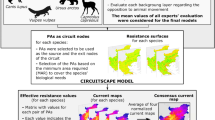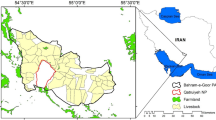Abstract
Context
Landscapes and animal behavior can exhibit temporal variability and connectivity estimates should consider this phenomenon. In many species, timing of activities such as nesting, mate searching, and hibernation occurs during distinct periods in which movement events may differ, along with physical characteristics of the surrounding landscape.
Objectives
We estimate movement, landscape conductance, and patch importance for a turtle species across two seasonal activity periods (spring, late summer) in a fragmented agricultural region. Three connectivity approaches are compared to identify their advantages and disadvantages.
Methods
A least-cost distance model, circuit-based approach, and patch-based index were used to collectively describe the potential functional connectivity of Blanding’s turtle (Emydoidea blandingii) across a multi-temporal scale in an agricultural region of south western Ontario.
Results
Connectivity decreased further into the active season exhibited through lower conductance of the landscape and fewer pathways, while the importance of habitat nodes shifted due to temporal variability in the number and distribution of nodes. Models provided different yet complimentary information, with least-cost models overestimating discrete pathways yet providing a secondary measure of landscape barriers. The circuit-based model estimated corridors of least resistance providing an overall characterization of the landscape, while patch-based indices provided key information on the importance of individual habitat patches.
Conclusion
Findings highlight the importance of including a temporal aspect in connectivity modelling as results demonstrate a change in functional connectivity over time. We also recommend employing multiple connectivity metrics to capture variation in movement behavior.




Similar content being viewed by others
References
Adriaensen F, Chardon JP, De Blust G, Swinnen E, Villalba S, Gulinck H, Matthysen E (2003) The application of “least-cost” modelling as a functional landscape model. Landsc Urban Plan 64:233–247
Bardecki MJ (1982) The status of wetlands in southern Ontario. Wetlands 2:262–270
Bartelt PE, Klaver RW, Porter WP (2010) Modelling amphibian energetics, habitat suitability, and movements of western toads, Anaxyrus (Bufo) boreas, across present and future landscapes. Ecol Model 221:2675–2686
Beaudry F, deMaynadier PG, Hunter ML (2009) Seasonally dynamic habitat use by Spotted (Clemmys guttata) and Blanding’s Turtles (Emydoidea blandingii) in Maine. J Herpetol 43:636–645
Beier P, Majka DR, Newell SL (2009) Uncertainty analysis of least-cost modelling for designing wildlife linkages. Ecol Appl 19:2067–2077
Bender DJ, Tischendorf L, Fahrig L (2003) Using patch isolation metrics to predict animal movement in binary landscapes. Landscape Ecol 1:17–39
Bowne DR, Bowers MA, Hines JE (2006) Connectivity in an agricultural landscape as reflected by interpond movements of a freshwater turtle. Conserv Biol 20:780–791
Burel F, Baudry J (1995) Species biodiversity in changing agricultural landscapes: A case study in the Pays d’Auge, France. Agric Ecosyst Environ 55:193–200
Burel F, Baudry J (2005) Habitat quality and connectivity in agricultural landscapes: the role of land use systems at various scales in time. Ecol Indic 5:305–313
Calabrese JM, Fagan WF (2004) A comparison-shopper’s guide to connectivity metrics. Front Ecol Environ 2:529–536
Castilho CS, Marins-Sá LG, Benedet RC, Freitas TO (2011) Landscape genetics of mountain lions (Puma concolor) in southern Brazil. Mamm Biol 76:476–483
Chardon JP, Adriaensen F, Matthysen E (2003) Incorporating landscape elements into a connectivity measure: a case study for the Speckled wood butterfly (Pararge aegeria L.). Landscape Ecol 18:561–573
Coffin A (2007) From roadkill to road ecology: a review of the ecological effects of roads. J Transp Geogr 15:396–406
Congdon JD, Dunham AE, van Loben Sels RC (1993) Delayed sexual maturity and demographics of Blanding’s Turtles (Emydoidea blandingii): Implications for conservation and management of long-lived organisms. Conserv Biol 7:826–833
Congdon JD, Graham TE, Herman TG, Lang JW, Pappas MJ, Brecke BJ (2008) Conservation biology of freshwater turtles and tortoises. Conserv Biol Freshw Turtles Tort 5:015.2–015.12
Congdon JD, Kinney OM, Nagle RD (2011) Spatial ecology and core-area protection of Blanding’s Turtle (Emydoidea blandingii). Can J Zool 89:1098–1106
Epps CW (2007) Optimizing dispersal and corridor models using landscape genetics. J Appl Ecol 44:714–724
Fahrig L (2007) Non-optimal animal movement in human-altered landscapes. Funct Ecol 21:1003–1015
Fahrig L, Rytwinski T (2009) Effects of roads on animal abundance: an empirical review and synthesis. Ecol Soc 14(1):21
Fall A, Fortin M-J, Manseau M, O’Brien D (2007) Spatial graphs: Principles and applications for habitat connectivity. Ecosystems 10:448–461
Forman RTT (1998) Road ecology: a solution for the giant embracing us. Landscape Ecol 13(4):III–V
Fortin MJ, James PM, MacKenzie A, Melles SJ, Rayfield B (2012) Spatial statistics, spatial regression, and graph theory in ecology. Spat Stat 1:100–109
Galpern P, Manseau M, Fall A (2011) Patch-based graphs of landscape connectivity: a guide to construction, analysis and application for conservation. Biol Conserv 144:44–55
Gibbs JP, Shriver WG (2002) Estimating the effects of road mortality on turtle populations. Conserv Biol 16:1647–1652
Howey MCL (2011) Multiple pathways across past landscapes: circuit theory as a complementary geospatial method to least cost path for modelling past movement. J Archaeol Sci 38:2523–2535
Koen EL, Garroway CJ, Wilson PJ, Bowman J (2010) The effect of map boundary on estimates of landscape resistance to animal movement. PLoS ONE 5(7):e11785
Lesbarrères D, Ashpole SL, Bishop CA, Blouin-Demers G, Brooks RJ, Echaubard P, Govindarajulu P, Green DM, Hecnar SJ, Herman T, Houlahan J, Litzgus JD, Mazerolle MJ, Paszkowski CA, Rutherford P, Schock DM, Storey KB, Lougheed SC (2014) Conservation of herpetofauna in northern landscapes: Threats and challenges from a Canadian perspective. Biol Conserv 170:48–55
McRae BH, Kavanagh DM (2011) Linkage mapper connectivity analysis software. The Nature Conservancy, Seattle. www.circuitscape.org/linkagemapper
Marchand MN, Litvaitis JA (2004) Effects of habitat features and landscape composition on the population structure of a common aquatic turtle in a region undergoing rapid development. Conserv Biol 18:758–767
McRae BH, Dickson BG, Keitt TH, Shah VB (2008) Using circuit theory to model connectivity in ecology, evolution, and conservation. Ecology 89:2712–2724
Meegan RP, Maehr DS (2002) Landscape conservation and regional planning for the Florida panther. Southeast Nat 1:217–232
Millar CS, Blouin-Demers G (2011) Spatial ecology and seasonal activity of Blanding’s turtles (Emydoidea blandingii) in Ontario, Canada. J Herpetol 45:370–378
Moore JA, Tallmon DA, Nielsen J, Pyare S (2011) Effects of the landscape on boreal toad gene flow: does the pattern-process relationship hold true across distinct landscapes at the northern range margin? Mol Ecol 20:4858–4869
Mui AB (2015) A multi-temporal remote sensing approach to freshwater turtle conservation: In: Chapter 3—modelling seasonal wetland habitat suitability for Blanding’s turtles (Emydoidea blandingii) using optical satellite remote sensing imagery. PhD thesis, University of Toronto
Mui AB, Edge CB, Paterson JE, Caverhill B, Johnson B, Litzgus JD, He Y (2015a) Nesting sites in agricultural landscapes may reduce the reproductive success of populations of Blanding’s Turtles (Emydoidea blandingii). Can J Zool 94:1–7
Mui A, He Y, Weng Q (2015b) An object-based approach to delineate wetlands across landscapes of varied disturbance with high spatial resolution satellite imagery. ISPRS J Photogramm Remote Sens 109:30–46
Nuñez TA, Lawler JJ, McRae BH, Pierce DJ, Krosby MB, Kavanagh DM, Tewksbury JJ (2013) Connectivity planning to address climate change. Conserv Biol 27:407–416
Pascual-Hortal L, Saura S (2006) Comparison and development of new graph-based landscape connectivity indices: towards the priorization of habitat patches and corridors for conservation. Landscape Ecol 21:959–967
Pascual-Hortal L, Saura S (2008) Integrating landscape connectivity in broad-scale forest planning through a new graph-based habitat availability methodology: application to capercaillie (Tetrao urogallus) in Catalonia (NE Spain). Eur J Forest Res 127:23–31
Rayfield B, Fortin MJ, Fall A (2010) The sensitivity of least-cost habitat graphs to relative cost surface values. Landscape Ecol 25:519–532
Rayfield B, Fortin M-J, Fall A (2011) Connectivity for conservation: a framework to classify network measures. Ecology 92:847–858
Saura S, Bodin Ö, Fortin M-J (2014) Stepping stones are crucial for species’ long-distance dispersal and range expansion through habitat networks. J Appl Ecol 51:171–182
Saura S, Estreguil C, Mouton C, Rodríguez-Freire M (2011) Network analysis to assess landscape connectivity trends: application to European forests (1990–2000). Ecol Ind 11:407–416
Saura S, Torné J (2009) Conefor sensinode 2.2: a software package for quantifying the importance of habitat patches for landscape connectivity. Environ Model Softw 24:135–139
Scharlemann JP, Green RE, Balmford A (2004) Land-use trends in Endemic Bird Areas: global expansion of agriculture in areas of high conservation value. Glob Change Biol 10:2046–2051
Schulte-Hostedde G, Walters D, Powell C, Shrubsole D (2007) Wetland management: an analysis of past practice and recent policy change in Ontario. J Environ Manag 82:83–94
Schwartz MK, Copeland JP, Anderson NJ, Squires JR, Inman RM, McKelvey KS, Pilgrim KL, Waits LP, Cushman SA (2009) Wolverine gene flow across a narrow climatic niche. Ecology 90:3222–3232
Steen DA, Aresco MJ, Beilke SG, Compton BW, Condon EP, Kenneth Dodd C, Gibbs JP (2006) Relative vulnerability of female turtles to road mortality. Anim Conserv 9:269–273
Van der Ree R, Jaeger JAG, van der Grift EA, Clevenger AP (2011) Effects of roads and traffic on wildlife populations and landscape function: Road ecology is moving toward larger scales. Ecol Soc 16(1):48
Wang IJ, Savage WK, Shaffer B (2009) Landscape genetics and least-cost path analysis reveal unexpected dispersal routes in the California tiger salamander (Ambystoma californiense). Mol Ecol 18:1365–1374
Watts AG, Schlichting PE, Billerman SM, Jesmer BR, Micheletti S, Fortin M-J, Funk WC, Hapeman P, Muths E, Murphy MA (2015) How spatio-temporal habitat connectivity affects amphibian genetic structure. Front Genet 6:275
Zedler JB (2003) Wetlands at your service: reducing impacts of agriculture at the watershed scale. Front Ecol Environ 1:65–72
Zeller KA, McGarigal K, Whiteley AR (2012) Estimating landscape resistance to movement: a review. Landscape Ecol 27:777–797
Acknowledgements
The authors would like to thank J. Phillips, F. Dorombozi, A.Watts, and A. Norman for sharing their expertise, and R. Holmes, A. Mendoza, and K.Barber for field support. This study was funded by a National Sciences and Engineering Research Council of Canada (NSERC) Industrial Postgraduate Scholarship sponsored by the Toronto Zoo, an Ontario Graduate Scholarship, and the William G. Dean Ontario Graduate Scholarship in Science and Technology to A. Mui. Additional funds were provided by the Department of Geography, University of Toronto Mississauga, the Centre for Global Chance Science (University of Toronto, Department of Physics) and a CFI/ORF award to Y. He.
Author information
Authors and Affiliations
Corresponding author
Rights and permissions
About this article
Cite this article
Mui, A.B., Caverhill, B., Johnson, B. et al. Using multiple metrics to estimate seasonal landscape connectivity for Blanding’s turtles (Emydoidea blandingii) in a fragmented landscape. Landscape Ecol 32, 531–546 (2017). https://doi.org/10.1007/s10980-016-0456-9
Received:
Accepted:
Published:
Issue Date:
DOI: https://doi.org/10.1007/s10980-016-0456-9




